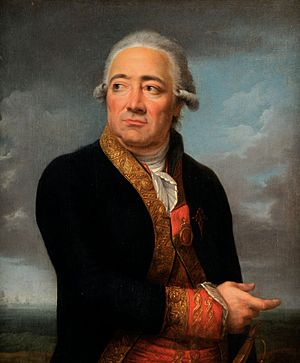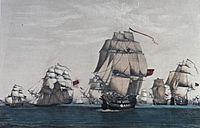Jose de Mazarredo y Salazar facts for kids
Quick facts for kids
Vice-Admiral Don Joseph Mazarredo y Gortázar
|
|
|---|---|

Portrait of Don José de Mazarredo by Jean François-Marie Bellier.
|
|
| Nickname(s) | El Bilbaíno |
| Born | 8 March 1745 Bilbao, Spain |
| Died | 29 July 1812 Madrid, Spain |
| Allegiance | |
| Service/ |
|
| Years of service | 1771–1805 |
| Rank | Admiral |
| Battles/wars | American Revolutionary War
|
| Signature | |
Don José de Mazarredo (1745–1812) was a very important Spanish naval officer. He was a commander, mapmaker, ambassador, and even an astronomer! Many people think he was one of Spain's best naval leaders ever. He was known for his smart ideas about naval tactics and for his bravery in battle.
Contents
José de Mazarredo loved the sea from a young age. When he was just 14, he joined the navy on a ship called the Andaluz. After serving for 12 years, he became an assistant in the naval department of Cartagena.
In 1772, he traveled to the Philippines on the frigate Venus. Two years later, he helped map the waters around South America. In 1775, he played a key role in a Spanish attack on Algiers, making important decisions about how the ships and soldiers should move.
Mazarredo also created a special system for the Spanish Navy to use. In 1778, he mapped the coast of the Iberian Peninsula. This work helped create a large book of sea maps, known as a Maritime Atlas.
Mazarredo was a very original thinker when it came to naval tactics. He wrote a book in 1776 called Rudimentos de Táctica Naval (Basics of Naval Tactics). This book helped junior officers learn how to fight at sea. His ideas were so good that the Spanish Navy used them during the American Revolutionary War.
He came up with new ideas for sea warfare. For example, he suggested using fireships (ships set on fire and sent towards the enemy) to help a fleet escape if it was in danger. He also had a clever way to break through an enemy's line of ships. If his fleet was in a good position, he suggested breaking through the middle of the enemy's line. This would split the enemy's fleet and make it harder for them to fight back.
Mazarredo also created a new signal book for the Spanish fleet in 1781. This book made it much easier for ships to communicate with each other during battles and other operations. It was a big improvement on older systems and helped the Spanish and French navies work together.
Fighting in the American Revolutionary War

Mazarredo had his biggest military success as the chief of staff for Admiral Luis de Córdova. In 1780, Mazarredo suggested a very bold plan. His fleet of 31 warships and 6 frigates attacked a large British convoy. This convoy had 63 merchant ships and was protected by a warship and two frigates.
Thanks to Mazarredo's plan, the Spanish captured 55 British merchant ships! They seized valuable cargo, including 80,000 muskets, many cannons, gunpowder, and over £1,000,000 in gold and silver. They also captured uniforms for many soldiers and about 3,000 British soldiers and sailors.
Two years later, he fought in the Battle of Cape Spartel, which did not have a clear winner. After the American Revolutionary War ended, Mazarredo went to Algiers as an ambassador. His job was to make peace after Spain had attacked the city.
Battles in the French Revolutionary Wars
In 1793, Mazarredo received a special military honor called the Order of Santiago. During the French Revolutionary Wars, Mazarredo's fleet from Cadiz joined another Spanish squadron in the Mediterranean Sea. He led several operations there, including rescuing soldiers and civilians from Roses, a city that was under attack by the French.
Mazarredo was not afraid to speak his mind. He warned the government that the Spanish navy was getting weaker because of bad management. This led to him losing his rank for a short time. However, after Spain suffered a big defeat at the Battle of Cape St Vincent, the navy asked him to come back.
Mazarredo then took command at Cadiz. In 1797, a British fleet led by Horatio Nelson tried to attack and bombard Cadiz. But Admiral Mazarredo had already prepared the city's defenses very well. The Spanish forces fought bravely, and the British fleet could not cause much damage. They left after two days.
In 1799, Mazarredo sailed his fleet from Cadiz to Cartagena. Around this time, Napoleon Bonaparte learned that the French Atlantic Fleet was in the Mediterranean. He also heard that Mazarredo's Spanish squadron was at Cartagena. Napoleon hoped that the French and Spanish fleets could join forces.
On June 21, 1799, the French fleet, led by Admiral Étienne Bruix, joined Mazarredo's fleet at Cartagena. Together, they had 42 battleships. This was a great chance to challenge the British in the Mediterranean Sea. However, Mazarredo did not want to work with the French on all their plans. He only agreed to help take back Minorca from Britain.
On July 7, 1799, Mazarredo's Spanish squadron chased and captured a British ship called the Penelope. After this, Mazarredo's fleet sailed to Brest, France, without any problems.
Later Years and Legacy
In 1804, Mazarredo became Spain's ambassador to France. He had given up his command of the fleet in Brest a few years earlier. He was known for being very honest and firm, which Napoleon did not always like. Napoleon wanted ambassadors who would agree with his plans more easily. Because Mazarredo spoke his mind and called Napoleon's plans "imperialistic and despotic," he was soon called back to Spain.
Even though he criticized the naval system later in his career, Mazarredo had a very successful naval career. He spent a lot of time at sea, commanded ships, and held important leadership roles. He also conducted tests to improve how ships were handled and how they signaled each other.
Don José de Mazarredo is remembered as one of the greatest Spanish naval commanders of all time.
See also
 In Spanish: José de Mazarredo para niños
In Spanish: José de Mazarredo para niños



